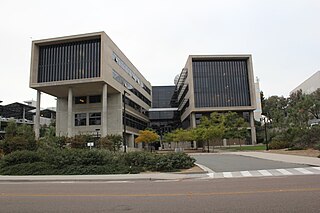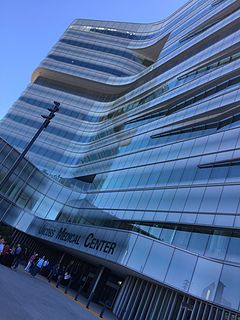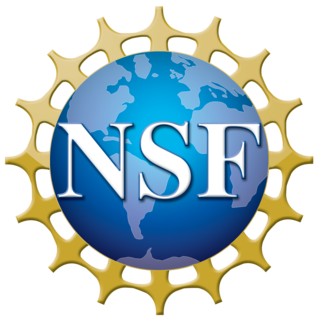
The University of California, San Diego is a public research university located in the La Jolla neighborhood of San Diego, California, in the United States. The university occupies 2,141 acres (866 ha) near the coast of the Pacific Ocean, with the main campus resting on approximately 1,152 acres (466 ha). Established in 1960 near the pre-existing Scripps Institution of Oceanography, UC San Diego is the seventh-oldest of the 10 University of California campuses and offers over 200 undergraduate and graduate degree programs, enrolling approximately 30,000 undergraduate and 8,500 graduate students.
The National Science Foundation Network (NSFNET) was a program of coordinated, evolving projects sponsored by the National Science Foundation (NSF) beginning in 1985 to promote advanced research and education networking in the United States. NSFNET was also the name given to several nationwide backbone computer networks that were constructed to support NSF's networking initiatives from 1985 to 1995. Initially created to link researchers to the nation's NSF-funded supercomputing centers, through further public funding and private industry partnerships it developed into a major part of the Internet backbone.

The Scripps Institution of Oceanography in La Jolla, California, founded in 1903, is one of the oldest and largest centers for ocean and Earth science research, public service, undergraduate and graduate training in the world. Hundreds of ocean and Earth scientists conduct research with the aid of oceanographic research vessels and shorebased laboratories. Its Old Scripps Building is a U.S. National Historic Landmark. SIO is a division of the University of California San Diego (UCSD). The public explorations center of the institution is the Birch Aquarium at Scripps. Since becoming part of the University of California in 1912, the institution has expanded its scope to include studies of the physics, chemistry, geology, biology, and climate of Earth.

The San Diego Supercomputer Center (SDSC) is an organized research unit of the University of California, San Diego (UCSD). SDSC is located at the UCSD campus' Eleanor Roosevelt College east end, immediately north the Hopkins Parking Structure.

The Preuss School, Preuss School UCSD, or Preuss Model School is a coeducational college-preparatory charter day school established on a $14 million campus situated on the University of California San Diego (UCSD) campus in La Jolla, California, United States. The school was named in recognition of a gift from the Preuss Family Foundation and is chartered under the San Diego Unified School District (SDUSD).

The Scorpio is a brand of underwater submersible Remotely Operated Vehicle (ROV) manufactured by Perry Tritech used by sub-sea industries such as the oil industry for general operations, and by the Royal Navy and the United States Navy for submarine rescue services. Originally developed by AMETEK Straza of El Cajon, United States, they were subsequently developed by Perry Tritech. Although the design of the original Scorpio is over several decades old, it forms the basis for a current generation of Scorpio-branded ROVs. Scorpio ROVs are named in a sequence following the order of manufacture, such as "Scorpio 17" or "Scorpio 45" which refer to specific ROVs.

UC San Diego Health is the academic health system of the University of California, San Diego in San Diego, California. It is the only academic health system serving San Diego and one of only two Level I trauma centers in the region. In operation since 1966, it comprises the UC San Diego Medical Center, Hillcrest; Jacobs Medical Center; Moores Cancer Center; Shiley Eye Center; and Sulpizio Cardiovascular Center, as well as several outpatient sites located throughout San Diego County. The health system works closely with the university's School of Medicine and Skaggs School of Pharmacy to provide training to medical and pharmacy students and advanced clinical care to patients.

ATMnet was a regional Internet service provider (ISP) located in San Diego, California, United States. It was formed in 1994 and operated until its purchase by Verio in November 1997 as part of the latter's national roll-up of regional ISPs.

The Corporation for Education Network Initiatives in California (CENIC) is a nonprofit corporation formed in 1997 to provide high-performance, high-bandwidth networking services to California universities and research institutions. Through this corporation, representatives from all of California's K-20 public education combine their networking resources toward the operation, deployment, and maintenance of the California Research and Education Network, or CalREN. Today, CalREN operates over 8,000 miles of fiber optic cable and serves more than 20 million users.

The University of California San Diego School of Medicine is the graduate medical school of the University of California San Diego in La Jolla, California. It was the third medical school in the University of California system and is the only medical school in the San Diego metropolitan area. It is closely affiliated with the medical centers that are part of UC San Diego Health.
Skyriver was a business broadband Internet provider headquartered in San Diego, California. It was acquired by One Ring Networks in July, 2018. Skyriver delivered broadband Internet connectivity for enterprise and small-medium businesses, utilizing its proprietary millimeter wave technology. Skyriver offered commercial grade services including dedicated Internet access, Virtual Private Network (VPN), redundancy, and temporary Internet/event bandwidth in California.
In telecommunications, white spaces refer to frequencies allocated to a broadcasting service but not used locally.

USS Snatch (ARS-27), well known as Scripps R/V Argo after conversion to scientific research, was a Diver-class rescue and salvage ship commissioned by the U.S. Navy during World War II and in service from 11 December 1944 through 23 December 1946. Her task was to come to the aid of stricken vessels. The ship is better known from her scientific research role as the Scripps Institution of Oceanography (SIO) research vessel R/V Argo. It is that name, apparently not formally recognized by Navy that maintained title to the vessel, found in the scientific literature and public releases about her wide ranging research voyages.
MV Kellie Chouest is a Deep Submergence Elevator Support Ship operated under the Military Sealift Command's Special Mission Ship Program and leased from Edison Chouest Offshore. It is assigned to COMSUBDEVRON FIVE for deep water rescue, salvage and research missions.

The California Institute for Telecommunications and Information Technology (Calit2, previously Cal(IT)2), also referred to as the Qualcomm Institute at its San Diego branch, is a $400 million academic research institution jointly run by the University of California San Diego (UCSD) and the University of California, Irvine (UCI). Calit2 was established in 2000 as one of the four UC Gray Davis Institutes for Science and Innovation. As a multidisciplinary research institution, it is conducting research discovering new ways in which emerging technologies can improve the state's economy and citizens' quality of life. Keeping in mind its goal of addressing large-scale societal issues, Calit2 extends beyond education and research by also focusing on the development and deployment of prototype infrastructure for testing new solutions in real world environments. Calit2 also provides an academic research environment in which students can work alongside industry professionals to take part in conducting research and prototyping and testing new technologies.
The UCSD Student-Run Free Clinic Project is a nonprofit free clinic that maintains four community locations and is headquartered at the University of California San Diego School of Medicine, La Jolla, California. The UCSD Student-Run Free Clinic Project is 1 of approximately 24 student-run clinic programs in the nation; students plan, manage, and carry out clinic operations under the supervision of licensed physicians. The UCSD Student-Run Free Clinic Project seeks to provide high-quality and comprehensive care to uninsured and underserved patients throughout San Diego, who cannot otherwise afford access to care; the majority of patients are working poor. Its four clinics are located at the First Lutheran Church in Downtown San Diego, the Pacific Beach United Methodist Church in Pacific Beach, Baker Elementary School located just north of National City, and Golden Avenue Elementary School in Lemon Grove.
The Irwin and Joan Jacobs School of Engineering is an undergraduate and graduate-level engineering school offering BS, BA, MEng, MS, MAS and PhD degrees at the University of California San Diego in La Jolla, California. The Jacobs School of Engineering is the youngest engineering school of the nation's top eleven, the largest by enrollment in the University of California system, and the ninth-largest in the country. More than thirty faculty have been named members of the National Academies. The current dean of the Jacobs School of Engineering is Albert P. Pisano.
Mushroom Networks, Inc. is a privately held company in San Diego, California.
CineGrid is a non-profit organization based in California that began in 2004 in order to distribute 1 Gbit/s to 1 Pbps digital networks, utilize grid computing to manage digital media applications, and increase the demand for digital media exchange among remote participants in science, education, research, art and entertainment. With its headquarters at the California Institute for Telecommunications and Information Technology, renamed in 2013 as Qualcomm Institute (Qi) in San Diego, California CineGrid is composed of 61 separate organizations and corporations. CineGrid has facilitated grants for its members through the National Science Foundation and provides access to Ethernet VLAN and TCP/IP connectivity.

The UC San Diego Medical Center, Hillcrest is one of two medical centers of UC San Diego Health and the primary teaching hospital for the University of California San Diego School of Medicine.























